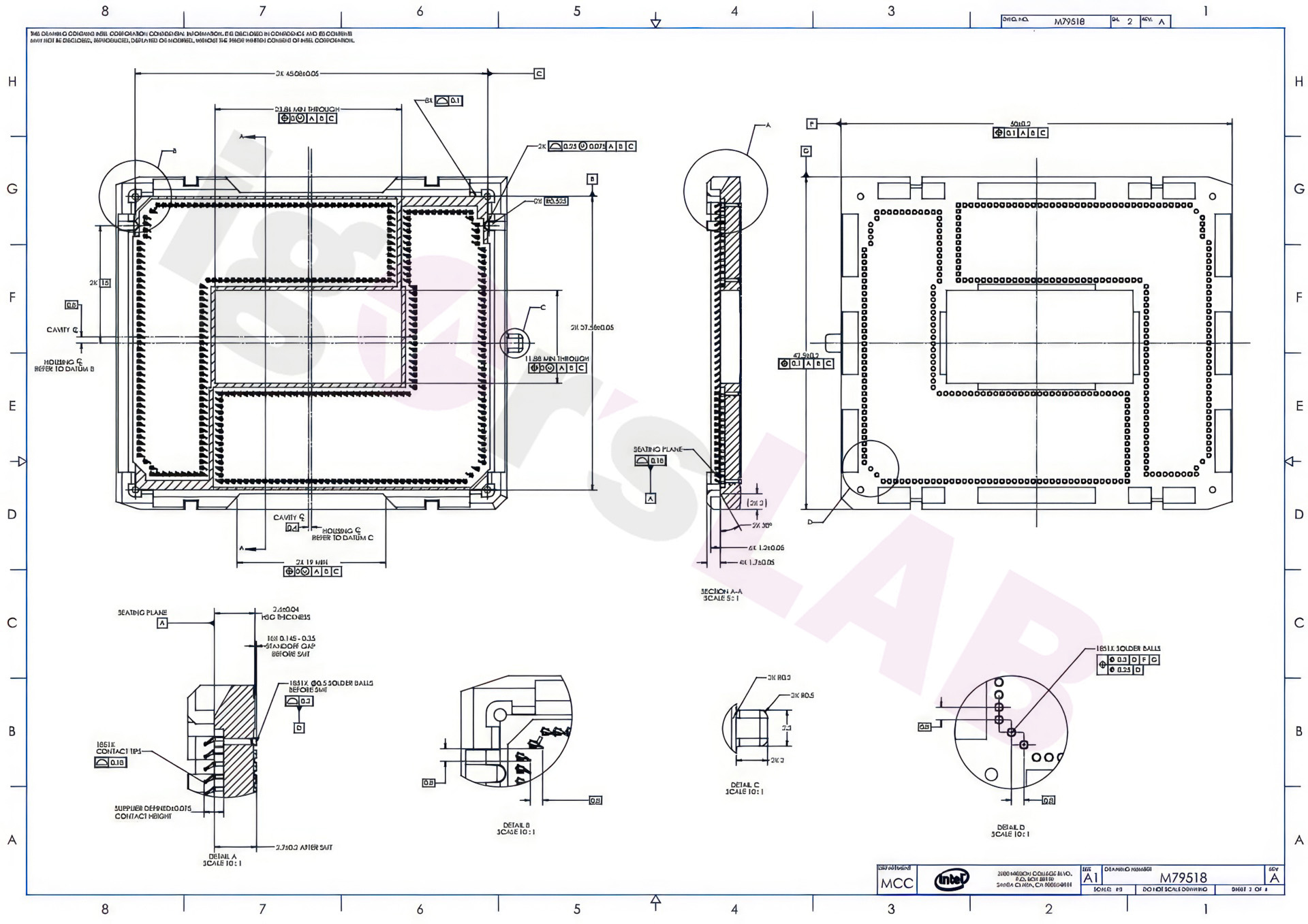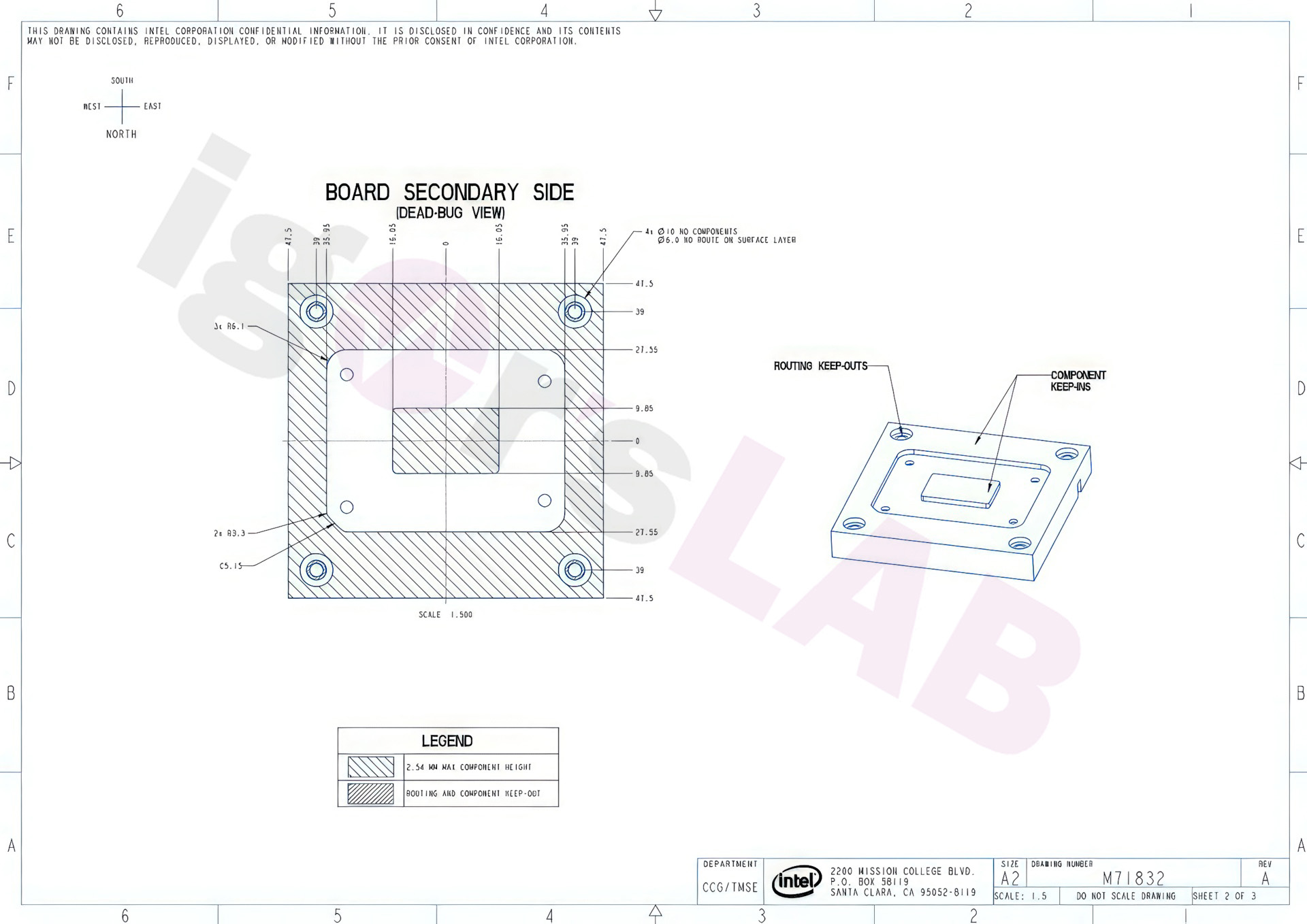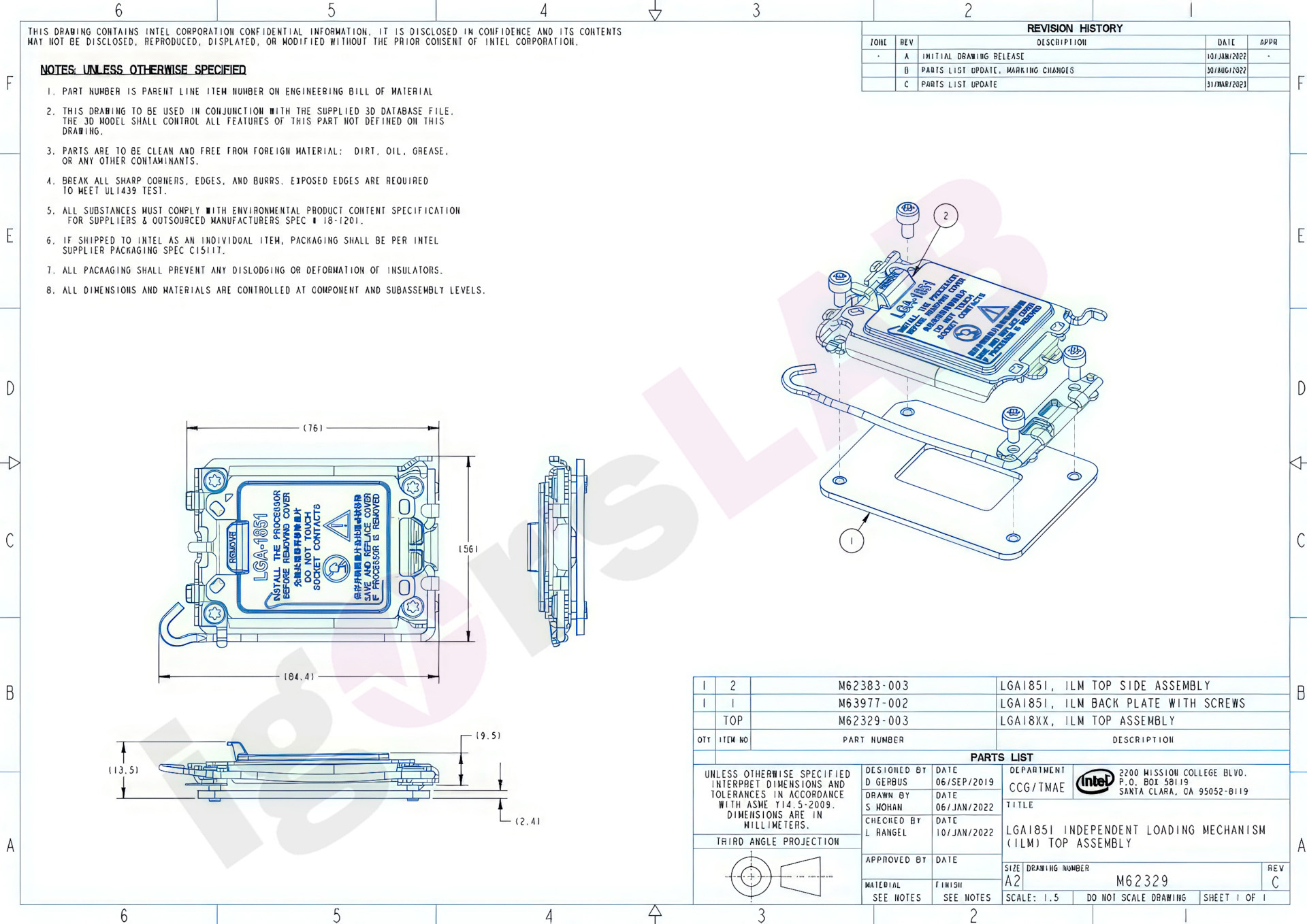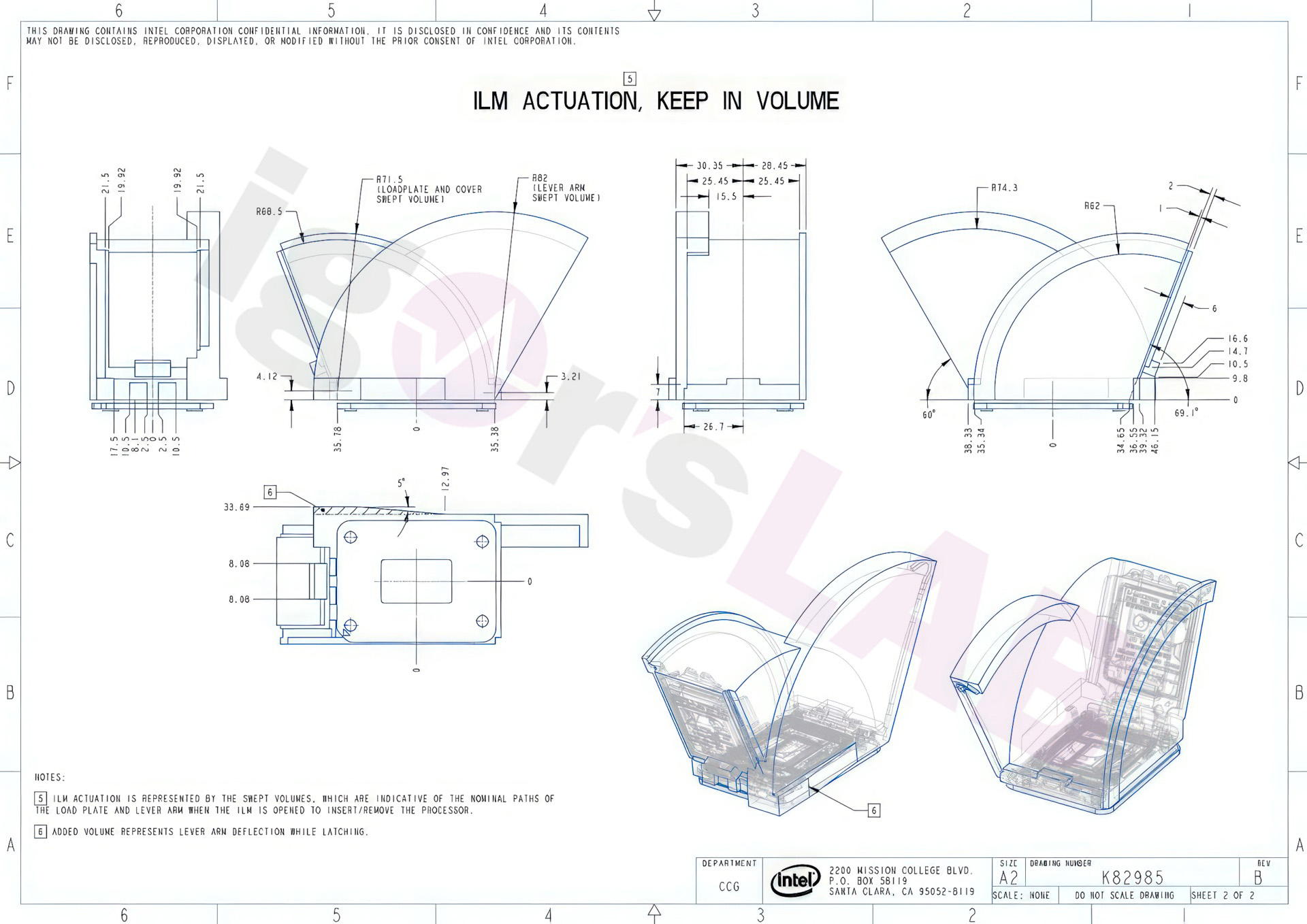Intel LGA1851 Socket For Future Arrow Lake CPUs Detailed

Intel is preparing its Arrow Lake processors to rival the best CPUs in 2024. Igor's Lab recently dropped a bomb on the hardware world, leaking the performance projections for Arrow Lake. Making good on its promise, the German news outlet has revealed information on the forthcoming LGA1851 socket that will house the new Arrow Lake parts.
The LGA1851 socket, as its name reveals, will sport 1,851 pins, 9% more than the current LGA1700 socket. Increasing pins will help improve the I/O interfaces and close the gap with AMD's AM5 socket. As a quick summary, the LGA1700 platform only provides a single PCIe 4.0 x4 interface for SSDs. The downside to this design is that PCIe 5.0 SSDs have to fight with graphics cards for the available PCIe lanes. Igor's Lab provided the schematics for the LGA1851 socket, showing the increase in the PCIe area to provide more bandwidth. The LGA1851 will reportedly arrive with a PCIe 5.0 x4 interface, finally bringing native support for PCIe 5.0 SSDs. Therefore, the primary PCIe x16 slot will be left alone.
Additionally, Arrow Lake will seemingly offer a second PCIe 4.0 x4 interface for SSD usage. It doesn't provide the same features as Zen 4, but it's a welcome upgrade over Raptor Lake. For example, Zen 4 supplies a PCIe 5.0 x16 interface for graphics cards and up to two PCIe 5.0 x4 slots for SSDs. In a scenario where all M.2 slots and expansion slots are populated, the configuration drops to x8/x4/x4.



The LGA1851 socket measures 45 x 37.55mm, the same dimensions as the LGA1700. Therefore, the pin increase didn't affect the socket's size. The Z-height, the distance from the top of the motherboard to the top of the processor's IHS, and the tolerance limits didn't change. The Total Static Compressive Load is still the same as well.
Intel's Alder Lake processors suffered from warping and bending in the socket, which has made LGA1700 frames very popular. While the information talks about the Board Transient Bend Strain on the LGA1851 socket, it doesn't provide any guidelines. It just suggests that vendors contact a local quality engineer.
The maximum dynamic pressure for the LGA1815 socket has increased from 489.5N to 923N, an 89% increase. In layman's terms, it'll require more pressure from CPU coolers. You may be able to conserve your CPU cooler but will need a new mounting kit. According to Igor's Lab, Intel has reportedly sent information to CPU cooler vendors to prepare new cooling products for Arrow Lake processors.




The diagrams reveal that the LGA1851 socket looks almost identical to the LGA1700. You couldn't tell the two apart if it weren't for the 151 extra pins. The design of the socket cover remains uncertain. One render shows the LGA1851 socket cover resembling the design that Intel has previously used for its HEDT LGA2066 socket. Another render shows an identical design to Intel's socket cover for the LGA1700 socket.
Get Tom's Hardware's best news and in-depth reviews, straight to your inbox.
Meanwhile, the LGA1851 socket retention system is the same one that Intel uses for the LGA1700 socket. The processor installation process hasn't changed. You start by lifting the Independent Loading Mechanism (ILM) lever and aligning the processor with the socket cutouts for a proper installation. Then you lower the load plate, apply pressure to the lever downwards, and slide it into the retention tab, and the socket cover will pop right off.











The LGA1851 socket was originally rumored for Intel's Meteor Lake and Arrow Lake processors. However, with recent rumors of Intel allegedly axing Meteor Lake for the desktop, Arrow Lake will be the first processor to slide into the LGA1851 socket. Arrow Lake won't arrive until 2024, so there's still a lot of time for last-minute changes.
Upgrading to Arrow Lake won't be cheap. The hybrid chips will require a new LGA1851 motherboard with an 800-series chipset and DDR5 memory. You won't be able to recycle your DDR4 memory for the next-generation chips. You may also need to buy a new CPU cooler, but we won't know for sure until Arrow Lake officially launches.

Zhiye Liu is a news editor, memory reviewer, and SSD tester at Tom’s Hardware. Although he loves everything that’s hardware, he has a soft spot for CPUs, GPUs, and RAM.
-
bit_user From what I can tell, neither this nor the Igor's Lab article says what's happening to DMI (i.e. the chipset link). Currently, it's PCIe 4.0 x8. What's happening with its speed and width?Reply -
usertests ReplyThe maximum dynamic pressure for the LGA1815 socket has increased from 489.5N to 923N, an 89% increase. In layman's terms, it'll require more pressure from CPU coolers. You may be able to conserve your CPU cooler but will need a new mounting kit.
What? Why? -
who_farted I am surprised we still have to deal with the fragility of pins. Why can't we just have a pad to pad connection?Reply -
Dantte Reply
Pads dont have tolerances and must be on a perfectly level surface to make contact.who_farted said:I am surprised we still have to deal with the fragility of pins. Why can't we just have a pad to pad connection?
Your question is like saying: "why cant we have heat sinks that dont require TIM?" You know why we have TIM, because the surfaces are not perfectly level and we need a (Thermal Interface) Material between them to fill in the gaps. The "pins" on a processor have tolerances and fill in those gaps between the socket and processor, some go a little deeper, some a little shallow, but they still make contact, pads cant do this. -
Friesiansam Whizzo! Another new socket, another new motherboard etc...Reply
On the other hand you could go AM5 and be able to upgrade the CPU in a few years, to the latest thing, without needing a new motherboard. -
InvalidError Reply
I'm guessing the doubling of mounting pressure is because the pin density increase is achieved using stubbier pins.usertests said:What? Why?
It doesn't have to be perfectly flat. Only flat enough that mounting pressure, compressibility and flex can take care of whatever gaps remains. Plate extra thickness on the pads and it should be fairly doable.Dantte said:Pads dont have tolerances and must be on a perfectly level surface to make contact. -
gggplaya Alder Lake launched in November 2021 which was 20 months ago and Raptor lake launched 8 months ago. So 2 gens on a socket? Assuming Arrow lake comes out in q4 2024 or Meteor lake comes out sooner with LGA1851 or as Mobile only.Reply
I'll stick with AMD, I like what they did with AM4. It wasn't perfect, it was hard to foresee future feature updates added to new chipsets. But it was much better than this, where Intel changes the socket completely after only 2 gens. At least AMD attempted to make older x370 motherboard future compatible with fragmented bios updates. -
Amdlova Will come with the alluminium thing to not bending the socked...Reply
Will need the bender of Futurama -
InvalidError Reply
That is only relevant to maybe 2-3% of PC owners. Between laptops, SBCs and similar highly integrated solutions people use as x86 PCs, 80+% of PC owners have CPUs soldered to the motherboard.Friesiansam said:On the other hand you could go AM5 and be able to upgrade the CPU in a few years, to the latest thing, without needing a new motherboard.
By the time I want to upgrade my i5-11400, I'll likely want new-everything just like every other time I have upgraded.
Intel has been doing two CPU generations per socket for the last ~25 years apart for one or two cases where there was only one, nothing new there.gggplaya said:Alder Lake launched in November 2021 which was 20 months ago and Raptor lake launched 8 months ago. So 2 gens on a socket? Assuming Arrow lake comes out in q4 2024 or Meteor lake comes out sooner with LGA1851 or as Mobile only. -
cyrusfox The only questions I have that are still unclear,Reply
•Mounting, will it be cross compatible with LGA1700?
•PCIE cpu lanes and DMI, Any different from 700 series?
•DLVR?